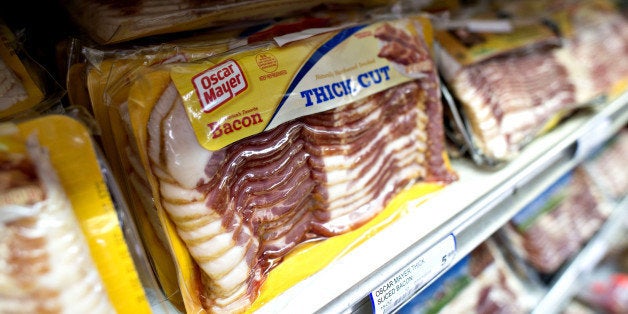
Shopping for bacon should be a joyous experience. But all too often these days, it's just confusing.
Some supermarkets sell dozens of varieties. As bacon has gained in popularity, labels such as "applewood-smoked" and "dry rubbed" have proliferated to the point where the bacon section can be completely bewildering -- even to a professional food writer like me. And with bacon prices hovering near all-time highs, it would be irresponsible to make a choice without full knowledge.
To help make sense bacon labels, I enlisted Joseph Sebranek, distinguished professor of animal sciences at Iowa State University, one of the country's foremost experts on cured meat. It turns out some labels are actually pretty significant, but others can be safely ignored. Here's what Sebranek had to say about labels you're likely to encounter.
Labels About Curing
"Curing refers to the interaction of the nitrates with the meat to develop the color, some of its antimicrobial properties and also a bit of taste," Sebranek said. It's basically what sets bacon apart from raw pork belly. The conventional bacon-curing method is to inject the belly with a solution of salt, sugar, phosphates and nitrates. If you don't see any curing-related label, you can probably assume the producer used this default method. But not all of them do.
Sugar cured and maple bacon: These two terms usually refer to the ingredients used in the curing solution. Since the default solution includes sugar, "sugar cured" isn't very significant. Maple bacon, though, is usually cured with a solution that includes some maple syrup, which could affect the flavor. Sebranek said you can always confirm the makeup of the curing solution by looking at the ingredients listed on the package. If there's really maple in there, it should say so.
Reduced sodium: Most bacon contains about 2 percent to 3 percent salt by weight when it's cooked, according to Sebranek. "Reduced sodium" bacon contains less, which means the curing solution contains less salt than usual. That's great for people who, for whatever reason, are trying to cut down on sodium. But Sebranek said there are also drawbacks. "Salt is an important part of that bacon flavor," he said. "You can take some of that out, but if you go too far, the product starts tasting flat. So there's a limit to how far you can reduce the sodium."
No sugar: This means that the curing solution contains no sugar. Obviously.
Uncured: This is perhaps the trickiest label of all. According to Sebranek, most so-called "uncured" bacon is actually... cured. It's still injected with a solution that sets its color and keeps it from spoiling. The difference is that the solution used in "uncured" bacon doesn't include artificial nitrates. Instead, the nitrates come from natural sources -- usually celery juice or celery extract, which is naturally rich in nitrates, but sometimes sea salt with high levels of nitrates.
"If you look carefully at the label, you'll see that these naturally cured products have to say something like, 'Contains nitrates from celery extract,'" he explained.
Sebranek traced the popularity of so-called "uncured" bacon to a series of scientific papers published in the 1970s that appeared to show a link between nitrates and cancer. Subsequent research hasn't been so definitive, but the American Cancer Society says studies show an increased cancer risk from eating even a small amount of processed meat over many years.
If you're trying to avoid nitrates altogether, Sebranek said you should look for bacon that's brown or grey rather than red, often a telltale sign that the product never underwent a true cure. But he said such products are exceedingly rare, and they taste very different from cured bacon.
Dry cured or dry rubbed: This one's legit. The makers of "dry cured" or "dry rubbed" bacon apply a dry mixture of ingredients to the surface of the bacon, rather than injecting an aqueous solution into the meat. It takes weeks, or even months, for this method to completely cure the meat, whereas conventional injecting takes mere minutes.
"The connoisseurs in the industry often claim that they experience a different flavor with dry-cured meat," Sebranek explained. "I think there's some potential good reasons for that. It's a different process completely. It doesn't involve as much water. The bacon ends up with a higher salt content."
Of course, the time and effort involved means dry-cured bacons tend to be significantly more expensive than their traditional counterparts.
Labels About Smoking
Once a pork belly has been cured, it's traditionally smoked and heated to about 130 degrees. This adds the distinctive smoky flavor we all love, helps set the red, cured color, and makes the bacon easier to slice. But today, industrial bacon manufacturers often cut corners in the smoking stage by applying a concentrated smoke liquid, then heating it, instead of putting the belly in an actual smoker.
Hardwood smoked or naturally smoked: If a bacon is labeled "hardwood smoked" or "naturally smoked," though, it has actually gone into a smoker, instead of just being injected with liquid smoke.
Applewood smoked or mesquite smoked: Many bacon labels are even more specific than that -- specifying the kind of wood used to generate the smoke.
"There's a significant difference between them -- you can see that in the chemistry -- though it's fairly subtle," Sebranek said. "It's kind of like wine. Some connoisseurs pick up different notes that they might think are better or worse, but most of us can't tell much of a difference."
Sebranek said apple and mesquite are especially prized by the people who care about such things.
Hickory smoked: This one is a bit of a ruse, Sebranek said.
"Hickory is used more frequently as a smoke source than most other words -- it's fairly conventional," he said. "Most of the products, if they're indicated smoked, but not a specific type of wood, more than likely, it was hickory. Putting 'hickory' on there just makes it a little more attractive to people, I guess."
Labels About Type
Organic: For most foods, "organic" is one of the most tightly regulated labels -- and bacon is no exception. To quality as USDA organic, the belly used to make the bacon must have come from a pig that was fed all USDA-certified organic feed and never given non-therapeutic antibiotics or growth hormones. In addition, the bacon can't include any artificial preservatives or additives, including artificial nitrates. That's why organic bacon is often labeled "uncured" as well. But these regulations cost serious money to meet, so Sebranek said organic bacon often costs more than twice as much as conventional bacon.
Center cut: This refers to bacon that comes from the center of the pork belly, as opposed to the periphery. "There's a connotation of this is a more premium cut," Sebranek explained. "It eliminates the ends, which tend to have a little more fat, so it may be a little more lean than other bacon. But as far as the taste goes, it's going to be the same."
Thick cut: This one's pretty self-explanatory -- the bacon is cut into thicker slices than normal. But Sebranek said the term is unregulated, so the actual thickness of "thick cut" bacon is at the discretion of each manufacturer. One brand's "thick cut" might be another brand's normal. If you're looking for especially thick bacon, the best thing to do is ignore the labels and compare the size of the slices by eye, keeping in mind that all bacon loses a lot of volume when it's cooked.
Microwave ready: There's nothing unusual about the bacon in this one -- the difference is in the packaging. "Microwave ready" bacon is contained in sleeves that are specially designed to facilitate cooking in the microwave. You pop the whole package in the microwave, zap it for the indicated amount of time, and you're done. Sebranek compared it to the microwave-ready packages of popcorn that have been staples of at-home movie nights for years.
Fully cooked: Fully-cooked bacon is crisp and ready to eat straight from the package. That sounds a little scary -- like it must involve some sort of nefarious high-tech processing. But Sebranek said it's normal bacon cooked by manufacturers basically the same way you would at home -- just on a much larger scale, using conveyor belts. But convenience comes at a price. "If you look closely at the prices, fully cooked product is going to be considerably more expensive than other bacon," he said. "Those packages are typically going to be fairly small -- maybe three ounces. But they'll often cost at least as much as a 12- or 16-ounce package of uncooked bacon."
What About Gluten?
With more and more Americans shunning gluten, food producers often tout gluten-free credentials. Some bacon producers have started to label their products "gluten-free" as well. On the face of it, that sounds, at best, absurd, and at worst, like a craven marketing tactic. Shouldn't it be obvious that bacon is gluten-free? But Sebranek said it's a little more complicated than that.
"Bacon does not normally include gluten, but in some processing plants there are other products being made that include grain ingredients that would include gluten," he said.
"Those that claim 'gluten-free' are typically processing the bacon in a plant or a separate area where there are no gluten ingredients of any kind used, even for other types of processed meats," Sebranek continued. "Thus, they can safely guarantee 'gluten-free.'"
